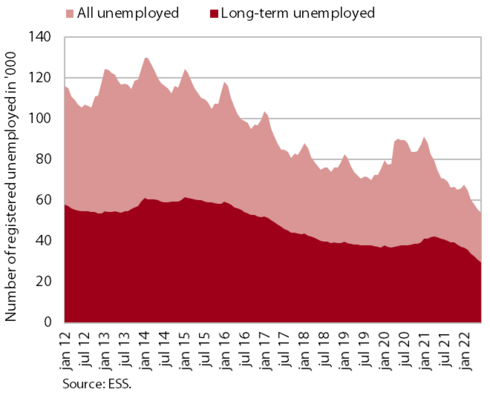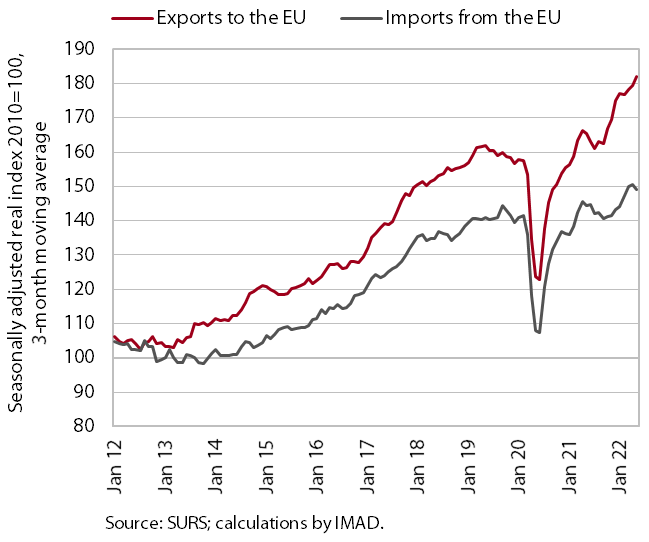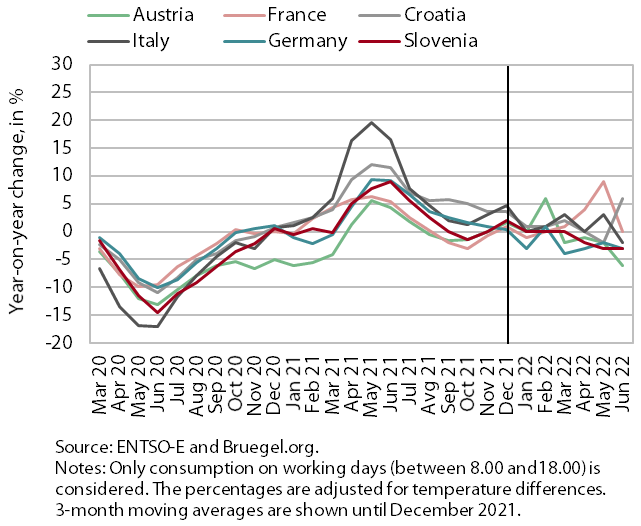Charts of the Week
Current economic trends from 4 June to 8 July 2022: registered unemployment, trade in goods and electricity consumption
At the end of June, 53,860 people were unemployed, which is almost a quarter less than a year ago and the lowest level since 1990. The number of long-term unemployed has also declined. Trade in goods with EU Member States increased slightly in May and was significantly higher than in the same period last year. Uncertainty in the international environment (war in Ukraine, rising inflation, supply chain disruptions) has also had a noticeable impact on sentiment in export-oriented activities in recent months, as export orders continue to decline and export expectations show strong monthly fluctuations. According to our estimates, higher prices may have already affected household electricity consumption, while industrial consumption was also affected by supply chain disruptions, material shortages and production adjustments, especially in energy-intensive companies.
Registered unemployment, June 2022

The number of registered unemployed persons reached a new low in June. The month-on-month decrease was the smallest (1.7%, seasonally adjusted) in 15 months. At the end of June, 53,860 people were unemployed (original data), which is 24.2% less than a year ago. Under conditions of high demand for labour, which is also reflected in the high vacancy rate, the number of long-term unemployed has also been declining since May last year – their number fell by a good quarter year-on-year in June. Among the long-term unemployed, the share of people who have been unemployed for more than two years increased (71%), as they have more difficulties in finding a job than other long-term unemployed.
Trade in goods, May 2022

Trade in goods with EU Member States increased slightly in May; uncertainty remains high. Real exports and imports of goods from and to EU Member States (seasonally adjusted) rose slightly in May and were significantly higher than a year ago. Compared to the same period in 2019 (i.e. before the epidemic), exports to EU Member States rose by 12.5% in real terms and imports by 4.4%. Trade with non-EU countries also increased compared to the same periods last year and before the epidemic, but fluctuates significantly from month to month due to operations involving processing, which account for more than half of trade with these countries. Uncertainty in the international environment (war in Ukraine, rising inflation, supply chain disruptions) has also had a visible impact on sentiment in export-oriented activities in recent months, as export orders continued to decline in June, while export expectations show stronger monthly fluctuations.
Electricity consumption, June 2022

In June, electricity consumption fell by 3% year-on-year – the same figure as in May. According to our estimates, part of the decline was due to lower household consumption compared to the same period last year, while the rest may be due to supply chain problems and material shortages, as well as the energy crisis and related production adjustments, especially in some energy-intensive companies. Among Slovenia’s main trading partners, higher consumption compared to June 2021 was recorded by Austria, Germany and Italy (-6%, -3% and -2 % respectively). In France, consumption remained unchanged year-on-year, while in Croatia it increased significantly (+6%), which we associate with favourable trends in tourism due to the relaxation of COVID-19 restrictions.
